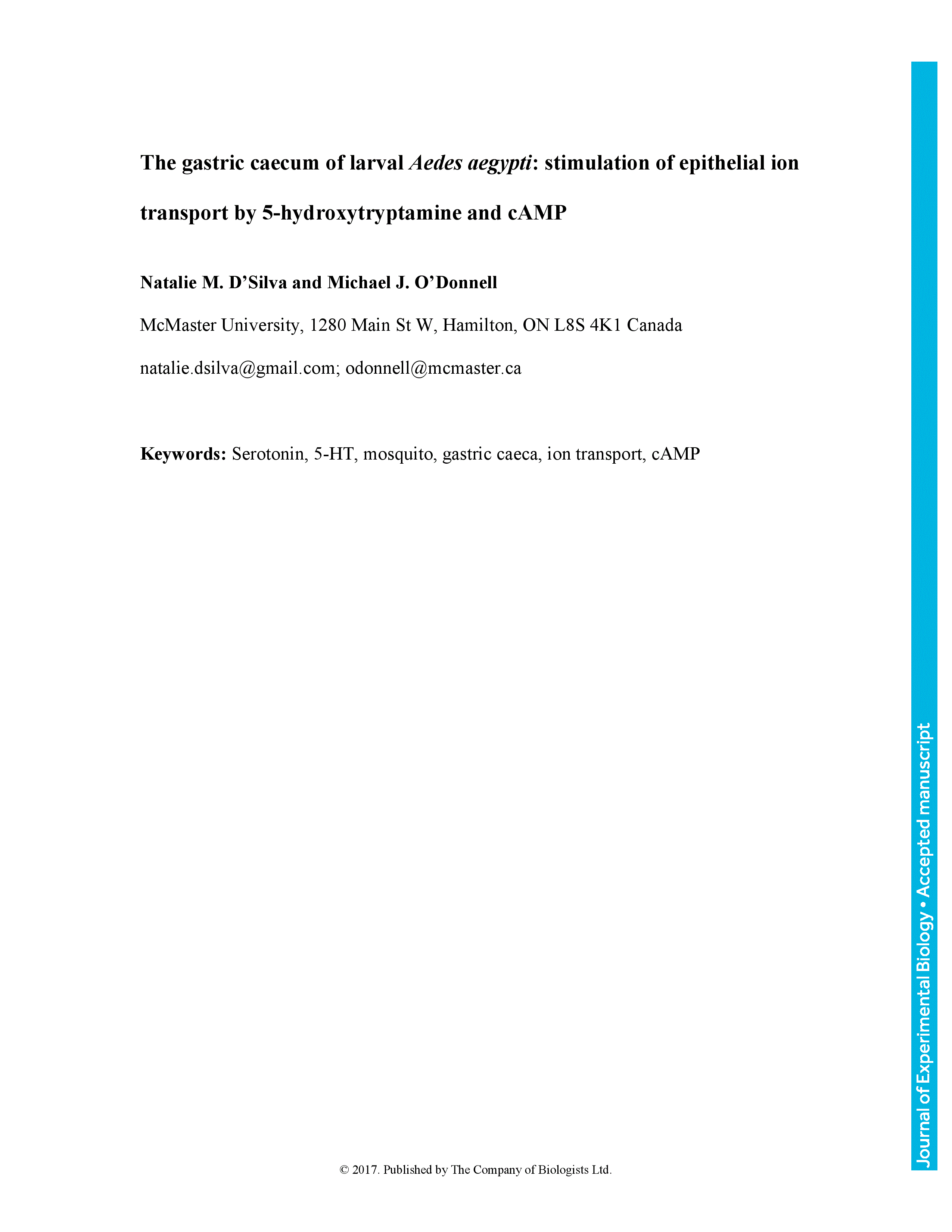We report measurements of ion transport across the gastric caecum of larvae of Aedes aegypti, a vector of yellow fever that inhabits a variety of aquatic habitats ranging from freshwater to brackish water. We provide the first measurements of the effect of 5-hydroxytryptamine (5-HT) on transepithelial potential (TEP), luminal ion concentrations and electrochemical potentials, as well as basolateral membrane potential and H+, Na+ and K+ fluxes. TEP, basolateral membrane potential, and H+, K+, and Na+ fluxes across the gastric caeca declined within 3-6 mins after isolation of the entire midgut from the larva. 5-HT restored both the TEP and active accumulation of H+, K+, and Na+ in the lumen. Additionally, 5-HT restored H+, K+, and Na+ fluxes across the distal caecum of freshwater larvae, and restored H+ fluxes across the distal caecum of brackish water larvae. There was no effect of 5-HT on ion fluxes across the proximal caecum. We have also shown that 5-HT restores the basolateral membrane potential in cells of the distal, but not proximal, caecum. Effects of 5-HT on TEP and basolateral membrane potential were mimicked by application of cAMP but not by a phorbol ester. We provide a working model which proposes that 5-HT and cAMP stimulate the vacuolar H+-ATPase of the distal caecum. Our results provide evidence that the gastric caecum is functionally distinct from the adjacent anterior midgut and we discuss possible roles of the gastric caecum in osmoregulation. We also describe similarities in the arrangement of ion transporters in the caecum with those of the Malpighian tubules.
The gastric caecum of larval Aedes aegypti: stimulation of epithelial ion transport by 5-hydroxytryptamine and cAMP
Currently Viewing Accepted Manuscript - Newer Version Available
Natalie M. D'Silva, Michael J. O'Donnell; The gastric caecum of larval Aedes aegypti: stimulation of epithelial ion transport by 5-hydroxytryptamine and cAMP. J Exp Biol 2017; jeb.172866. doi: https://doi.org/10.1242/jeb.172866
Download citation file:
Advertisement
2023 JEB Outstanding Paper Prize shortlist and winner

The JEB Editors are delighted to announce the shortlisted authors for the 2023 JEB Outstanding Paper Prize. Read the winning paper - Tiny spies: mosquito antennae are sensitive sensors for eavesdropping on frog calls - by Hoover Pantoja-Sanchez and Brian Leavell from Ximena Bernal's lab at Purdue University, USA.
JEB Science Communication Workshop for ECRs

If you’re an early-career researcher interested in science communication and are attending the SEB Annual Conference in Prague this summer, come a day early and join the JEB Editors at a sci comm workshop to learn the key writing skills needed to promote your research to a broad audience beyond your peers (1 July at 14.30-17.30). Places are limited to 24 attendees, and applicants should apply through the SEB registration page by 30 April 2024.
Bridging the gap between controlled conditions and natural habitats in understanding behaviour

Novel technologies enable behavioural experiments with non-model species, in naturalistic habitats and with underexplored behaviours. In their Commentary, Scholz and colleagues discuss how to obtain a deeper understanding of the natural ecology and lifestyle of study animals.
How a macrourid fish remains buoyant at depths it should be unable to reach

Fish with swimbladders should not be capable of descending below 7200m, but when Alan Jamieson and Todd Bond spotted a macrourid fish at 7259m, they knew they had seen something miraculous. Working with Imantes Priede, they reveal that the swimbladder of a 1 kg fish could hold 37.9 g of oxygen, sufficient to offset the weight of the fish's bones, and take 221-440 days to fill, which is plausible because it takes years for the fish to descend to such depths.
ECR Workshop on Positive Peer Review

Are you an ECR looking for tips on how to write concise, astute and useful manuscript reviews? If so, join the JEB Editors at a 2-hour JEB-sponsored Workshop on Positive Peer Review at the Canadian Society of Zoologists annual meeting in Moncton on 9 May 2024 at 13.00-15.00. There are 25 spaces for ECRs and selection is first come, first serve. To sign up, check the ECR Workshop box when you register for the CSZ meeting.



